Are you interested in Stand Up Paddling and would like to know about the different types of SUP and SUP boards?
Would you like to buy a Stand Up Paddle Board but don’t know exactly where to start?
We can help you!
In this article, you can read all about the different types of Stand Up Paddle Boards. We’ll explain to you:
- What are the different types of SUP boards
- Which applications do they have, and for whom they are suitable
- Examples of SUP boards
- What you also have to consider regarding the equipment
So here you can get a full overview of:
- All-around
- Cruising and Fitness
- Race
- Downwind
- Trekking and Touring
- Wave SUP
- Whitewater / Wild water
- Crossover Windsurfing SUP
- Yoga SUP
- Children’s SUP
And, as if that wasn’t enough, here are the 5 most important criteria that you should consider when choosing your SUP board!
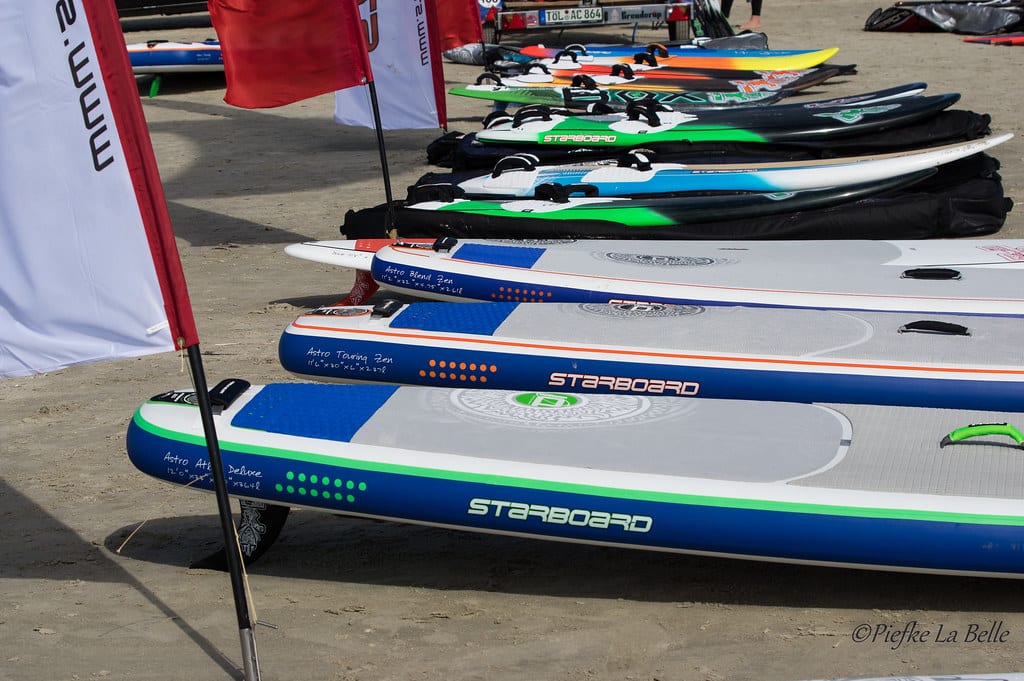
Why different Stand Up Paddle Boards are needed
Surfing is the origin of Stand Up Paddling as we know it today. However, due to the popularity in recent years of Stand Up Paddling, especially since 2007, various different variations of the SUP have been developed.
This now ranges from surfing waves to short tours, to multi-day trekking trips, to down-winds, to wind SUP (combination of wind and stand up paddle surfing) to foil boarding. And, of course, even this list is anything but complete.
Accordingly, various deck shapes (shapes of the boards) have developed along with the sport. In particular, different elements, such as stability, maneuverability, and speed, define the properties of the SUP board.
In this article, we would like to introduce, briefly and succinctly, the most important forms of the SUP board and show you the corresponding advantages and disadvantages.
Our goal is for everyone interested in SUP to be easily able to orient themselves and to find their way to the various providers more quickly for possible selection of a board or equipment. If you are already familiar with the different forms of Stand Up Paddling and would like to consider detailed features of your future board, we recommend taking a look at our Buyer’s Guide.
Allround SUP Boards: Ideal for beginners, fitness stand-up paddlers and family fun

The Allround boards are designed with the goal of having very balanced rafting qualities, thus being best suitable for beginners.
The typical Allround board is therefore ideal for SUP beginners and those who occasionally treat themselves to a small Stand Up Paddle trip [1].
You can use the Allround SUP Board for your first standing attempts as well as excursions in small waves or even for some tours with your dog.
But it can also be used to train your own fitness or for trips around a lake, and in most cases it is also a good choice for a family board.
The deck shape therefore is clearly designed with the goal of all-round use, i.e. for moderate and balanced driving qualities:
- The bow or nose usually has a wide and rounded shape.
- The rear is just as wide, often rounded or partially cut off.
- Allrounders have moderate board curves and rather soft edges

Allround Stand Up Paddle Boards are usually constructed from robust plastics and are therefore also are relatively impervious if you make contact with stony shores or ground surfaces.
For beginners, pleasure paddlers, and families, we recommend paying particular attention to the fact that the SUP board has a so-called “soft deck.” A soft deck is nothing more than a soft and non-slip surface. This not only makes standing itself more comfortable, but also helps in the event of a fall. Bonus SUP Tip: In particular, if you are thinking about going on a fishing trip with your SUP, or need the SUP mostly as a family “play island,” you should not avoid a soft deck board. [3]
Inflatable SUP: Why these are (almost) a Must for All-round boards

Even more sturdy and space-saving than the Hardboard Allrounder are the inflatable SUP boards: the so-called “Inflatables” or iSUPs [2].
As the name suggests, these can be inflated (relatively) easily on the beach with a suitable pump.
Due to their rubber fins, these boards are really extremely sturdy and suitable for children, as you cannot hurt yourself on otherwise sharp-edged fins with these rubber fins of the iSUPs.
Due to their rubber fins, these boards are really extremely sturdy and suitable for children, as you cannot hurt yourself on otherwise sharp-edged fins with these rubber fins of the iSUPs.
iSUPs are ideal for storing and transporting. and they can be used for years without any problems – if you pay attention to quality. If you want to use the Stand Up Paddle Board primarily together with the family (as a “play island” and/or as a tandem / multi-person board), you should certainly also consider buying a tandem SUP or family board and a sturdy Vario paddle, since you can adjust the paddle length to your body size (learn how to determine the right paddle length here) [4].

All-around SUP Boards: Conclusion
The Allround Board is the perfect choice for beginners, pleasure paddlers, fitness paddlers and families.
The all-round boards are currently usually offered in complete sets, so that you can obtain the correct and necessary equipment in one purchase quickly and conveniently, especially if you’re a beginner.
If you don’t live directly on the water and are mainly looking for a sturdy board for longstanding use, you shouldn’t dismiss considering iSUPs.
If you need more details, reviews and comparison about the great all-around Stand Up Paddle Boards, have a look at our in-Depth Review Section.
Cruising SUP Boards aka. Touring SUP Boards
Stand Up Paddle Fitness is an absolute blast! It burns more calories than most other trainings and is highly efficient as a full-body workout.
Even more: It not only builds up muscles and improves endurance, but also improves coordination and balance. For pure training purposes and if you plan to do workouts with your bodyweight on the board, a relatively wide all-round stand-up paddle board is a great choice. However, if the workout on the board is your main goal, you should have a deeper look at the Yoga Stand Up Paddle Boards.
In this section, we will focus on paddling fitness boards, which means that the paddling itself is the workout.
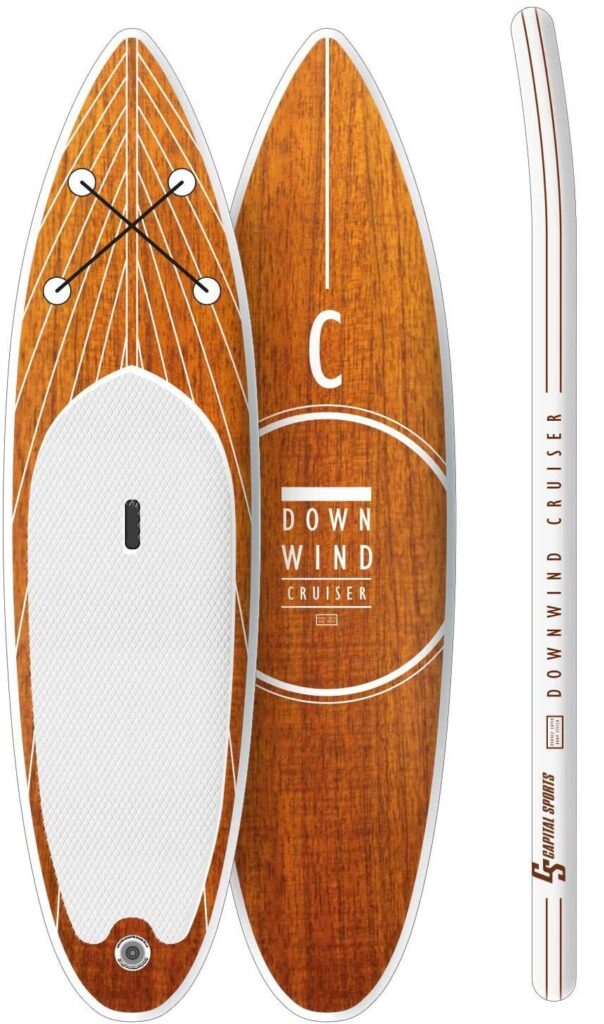
For physical paddle training and long rides however, the Cruising Board certainly is more suitable [6], [7]. So if your goal is to make long extensive SUP tours and thereby speed, cardio and strength is your focus, you should definitely opt for a Cruiser Stand Up Paddle Board like the RedPaddle Sport 11’3” or the Capital Sport Downwind Cruise. And purely fitness-oriented Stand Up Paddler can even go with something like the JP GT-S 12’6”.
In order to give the board more speed and improved gliding properties, the shape of the cruising board is visibly designed slimer. In contrast to the Allround SUP, the cruiser is characterized by the following:
- Curved deck shapes are gone, and thus, at first glance, the board is clearly much sleeker. An extreme example is the JP GT-S 12’6” shown below [8].
- Both the bow and the stern are much more pointed in the typical cruiser.
- Furthermore, the underwater portion is rather V-shaped
- The deck shape of the entire board is flatter
- Also the materials used in standard cruiser boards are chosen so that the weight is reduced with regard to speed.
However, the improved gliding characteristics also have a disadvantage: The cruiser boards are slightly less stable in the water. Therefore, they require a little more practice and skill for control, and they are somewhat more susceptible to damage due to their light materials.


Crusing SUP: Conclusion
Their sleeker deck shape makes cruisers the right choice for stand up paddlers who not only want to take longer rides, but who also care about speed and fitness training. However, the better gliding characteristics and optimization for speed mean that the boards are slightly less tilt-resistant and less sturdy.
Cruising SUP Boards are really fun and provides maybe one of the best option for full body training. However, you should already have some paddling experience in order to really ride them to the limit. So if you often want to kick up your speed on your SUP, and already have a good feel for and experience with stand up paddling, you should look at the cruisers
[6] Capital Sports Downwind Cruiser
[8] 2021 Red Paddle Co 11’3 SPORT
Race SUP Boards
If you completely focus on speed and put your own performance in the forefront in stand up paddling, you can even go a step further with the race boards.
But there are different categories in this group, again depending on what the purpose of the SUP board shall be.
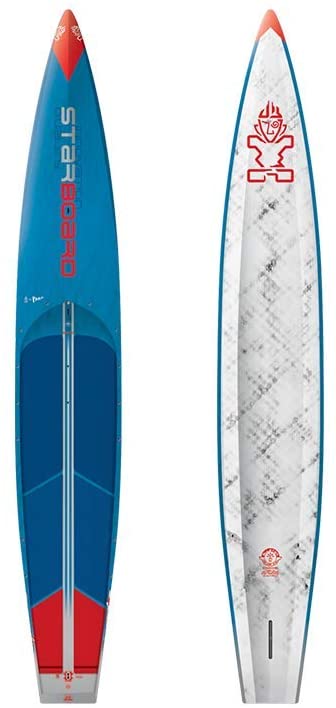
The SUP race boards are mainly divided into two classes:
- Sprinting and long distance boards for shallow water (see [9] – [12])
- Classes of the coast runners
Of course, the deck shape and size of the boards vary slightly depending on the type of application:
- Shallow water race boards are between 12”6′ and 14 feet long and have a relatively flat scoop-rocker line.
- Ocean boards or coast runners not only usually have a deeper nose to handle waves or chops, but they are also longer (16” to 18 feet).
Due to their deck shape and length, race boards are much less stable and really better suited to speed. Due to the slim layout of the Race SUP and the almost keel-shaped underwater portion as well as the flat rocker, you need a lot of experience to control the board.

The race SUP boards therefore should be ridden really fast and, above all, straight ahead. This means that the boards require significantly more experience in stand up paddling, especially when it comes to SUP technology, such as straight ahead and turning.
Race Stand Up Paddle Boards can be bought both as inflatables or iSUPs (see 12a], or of course as hard boards (e.g. [9], [10]). Thanks to considerable progress in recent years in the field of iSUP, these are now comparable in terms of sturdiness and rafting characteristics, and therefore they certainly are a good purchase.
But if you really want to focus on performance and for up for the last tenths of a second, you should not compromise: opt for a race hard board.
The paddles for race boards are designed logically for speed and efficiency. If you treat yourself to a race board, then a corresponding lightweight paddle in carbon construction simply should be part of it.
Race SUP: Conclusion
Race SUP boards are completely designed for speed. They are a lot of fun driving on the straight, as you can reach speeds that are otherwise not possible. But you need a lot more experience so that you really reach the speed efficiently and also have the ability to maneuver it, such as turning, with control.
[9] Naish 14’0 Maliko S25 25.0″
[10] Starboard 12’6′ X 23′ All Star Carbon
[12] JP 14’0 Allwater Race Pro SUP 2021 22.0″
[12a] Shark SUPs 14′ inflatable Race Boards
Downwind SUP Boards
Downwind Stand Up Paddling is a combination between race and wave SUP. The swell of the waves formed by the wind can be ridden with as much speed as possible.
Laird Hamilton and Dave Kalama, “co-inventors” of modern stand up paddling, were the first to paddle with the wind at Maliku Gulch on Maui’s north coast (along the famous tourist excursion “Road to Hana”), with the wind at the back of the coast, then still with normal 12-foot Malibu deck shapes.
Today, however, faster boards with a length of 12” to 18” feet are used for downwinding (often around 14 feet).
The deck shape is based on the race SUP boards, with a long and narrow outer deck shape (outline), which makes them extremely powerful.
In contrast to shallow water race boards, however, “downwinders” have a more scooped bow (curved rocker nose), to better surf the wave swells.
And there is even a more radical form of Downwind SUP Boards: The Coastrunner.
These very long versions even have a steering device, which helps maintain course more easily, especially in crosswinds.
The purebred downwind boards are mostly used on the ocean, as there are more desirable wave swells, in contrast to lakes or rivers.
Likewise, as with the race boards, the length of the downwind boards alone requires a lot of experience and technique, so that stand up paddling with these boards offers maximum enjoyment.
It must also be noted that the downwinders and race boards do not have a luggage device. This means that a hip or backpack with appropriate provisions, water, and wind and weather protection would be needed.
Since speed and long distances are mostly in the forefront when downwinding, we recommend a light carbon race paddle. Whether you choose a narrower or wider paddle blade depends largely on your own riding style. It is also important to remember that, when downwinding, you are usually relatively far out in the open water. In our opinion, you always need a coiled leash and possibly also a life jacket for your safety.
Downwind SUP Boards: Conclusion
Downwind boards, like race boards, are extremely optimized for performance and, when ridden correctly, are incredibly fun.
From our point of view, it only makes sense to use a real downwind board or even a Coastrunner if you have the experience and a highly advanced technique. If you occasionally want to surf in wave swells, you are also well served with a longer Allround Stand Up Paddle Board or the Cruiser Boards like the Capital Sports Downwind Cruiser.

[13] Starboard 12’6′ X 23′ All Star Carbon
[14] Capital Sports Downwind Cruiser
Adventure, Trekking and Touring SUP Boards
Whether it’s a day trip or if you even travel from station to station for several days with a tent and provisions: Adventure and Touring Stand Up Paddle Boards allow a trekking adventure on the water. With the right material, nothing stands in the way of adventure.
Remark: We call these boards also Touring SUPs, even though they slightly differ compared to the Cruising or Touring SUPs we described above. However, the difference is small. So of course, if you are already a skilled Stand Up Paddler, you can also use a pure-breed Fitness Touring SUP for your Trekking adventures.
Of course, you don’t have to have a separate board for every tour. If performance isn’t a primary factor, you can also enjoy short or even multi-hour tours in shallow water using a normal all-round board [16]. Something worth considering might be a SUP set with a kayak seat, so that you can paddle while sitting.
But if you focus on stand up paddle tours and even want to make multi-day trips, you should definitely rely on a real touring board.
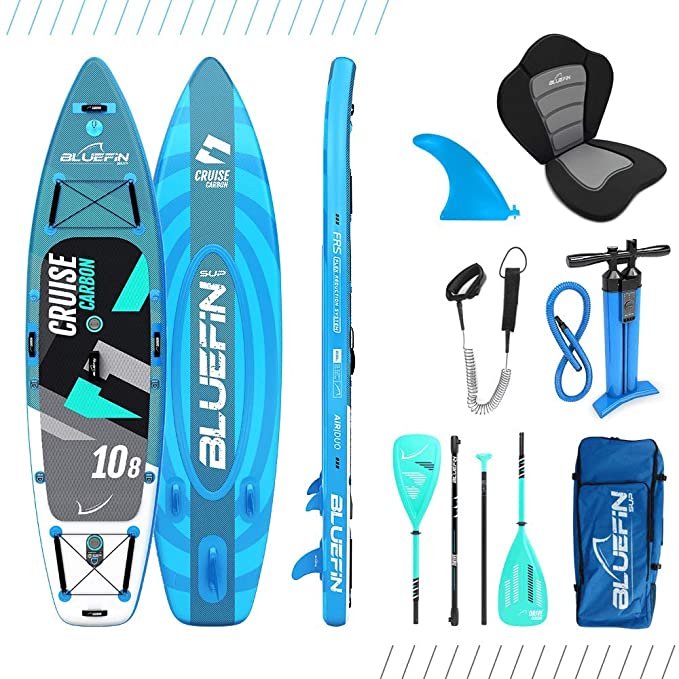
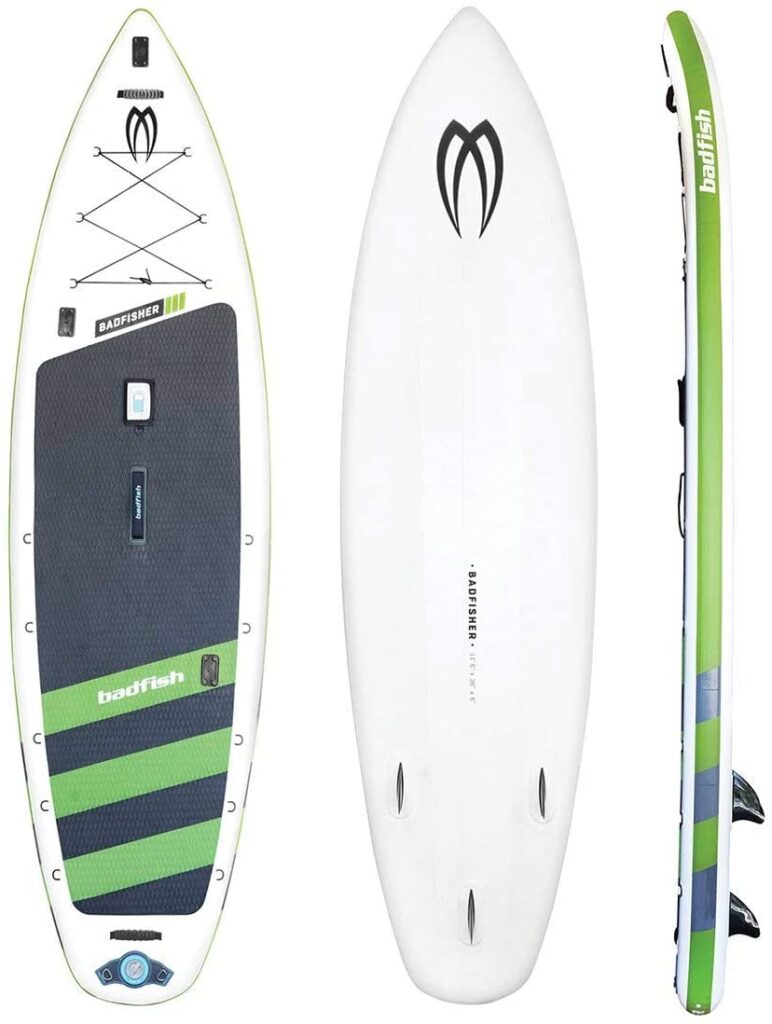
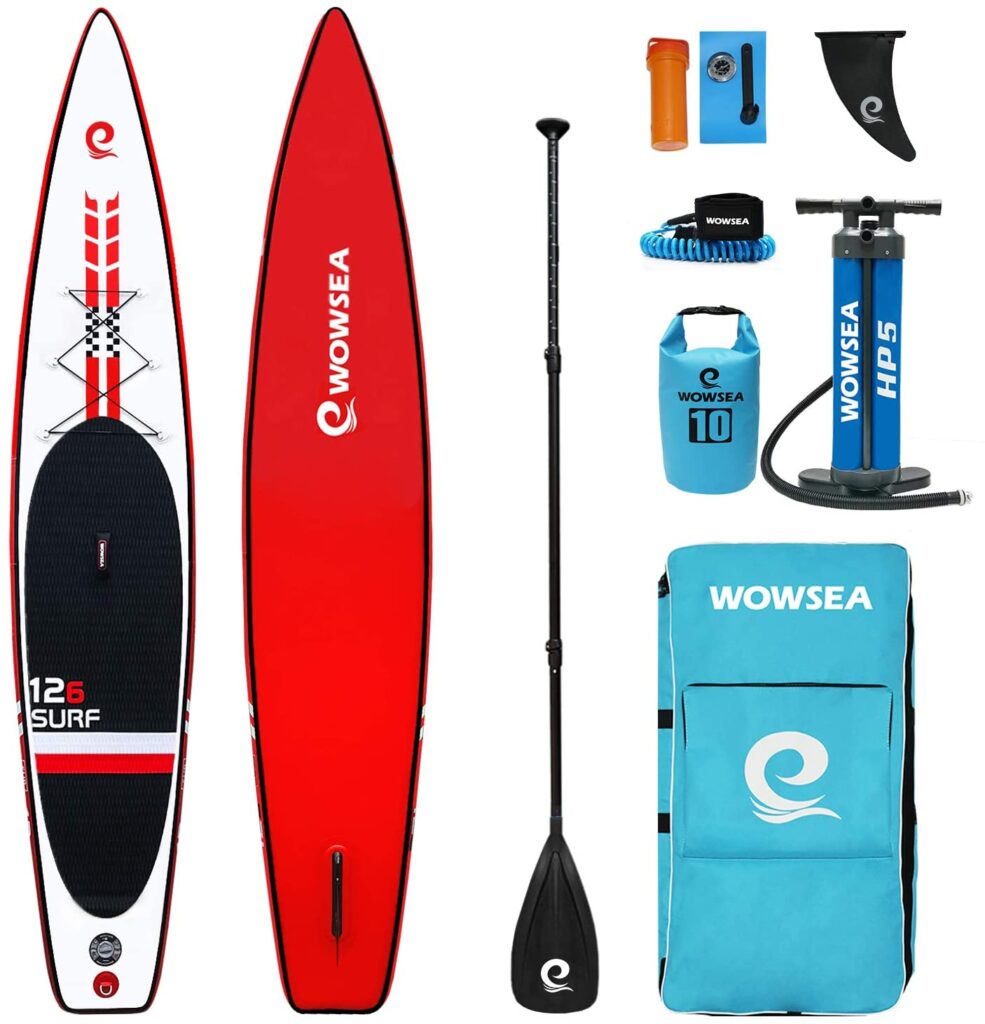
The typical touring board is not a racing machine, but thanks to its deck shape it performs well on the shallow water and also in the sea [17], [18], [20]. There are also more sporty versions of Touring or Trekking Boards like the Wosea Racer [19].
Consequently, the ideal Stand Up Touring Board is fast, stable, and carries up to a 60kg load with a volume of about 250 liters. If you need even more load, choose an extra-wide adventure board which you can also ride through turbulent waters with less risk of falling. Many of the adventure and touring boards offer attachments for luggage [21].
Touring and adventure SUP boards can also be hard boards or inflatables (iSUPs). We believe the iSUP is more suitable in this regard.
In particular, if you are planning multi-day or longer day trips, which may also include routes over land, the equipment can be stowed easily in the backpack. Due to their relative sturdiness, the inflatable Stand Up Paddle Boards are also better suited for river tours. It should be noted that the inflatables tend to have a slightly lower weight bearing capacity.
For longer tours, in addition to the choice of board, additional equipment is essential:
- Waterproof backpack and waterproof trekking bags (dry bags)
- Board with luggage device
- Coiled leash for safety, especially on offshore tours
- Lightweight, sectional paddles, which can also be easily stowed and transported
- Wind, cold, and sun protection: We recommend cool Lycra or thin wetsuits and, if necessary, waterproof hats or a cap
For a complete overview over all essential accessories for Stand Up Paddling and where to get them cost effectively, you should check this article:
Adventure and Trekking SUP Boards: Conclusion
Even tours lasting several hours with a little equipment can be done well with an all-round board with enough weight bearing capacity.
But you get the full outdoor feeling when you do multi-day tours with the SUP board. Here we strongly recommend a special touring or trekking Stand Up Paddle Board.
Make sure that you choose the volume of your board correctly so that you have about 60kg load capacity for your luggage. For trekking, we prefer inflatable boards. The iSUP boards are simply even sturdier and can be transported much more easily if you have a part of the route over land in front of you.
[16] Bluefin Cruise 10’8”
[17] Badfisher Fishing & Adventure SUP Board
[18] Fanatic Ray Air Touring SUP
Wave SUP Boards
The origin and the supreme art of Stand Up Paddling: surfing with the SUP Board!
Welcome to the playground and the birth of the SUP! For many, wave stand up paddling is of course the ultimate discipline. And it’s definitely fun.
In addition to the required handling skills, the right material is essential here. The first smaller wave rides can also be done with the all-round boards [21], but special wave boards are clearly required for higher waves.

The deck shape of the wave SUP board should be chosen depending on ability and wave height:
Wave Stand Up Paddle Boards are generally shorter and designed for maneuverability and speed. The bow is curved, i.e. bent to prevent “insertion” in the wave valleys. Wave SUP boards also have a more substantial tail rocker ,which promotes maneuverability.
The traditional long and all-round boards are suitable for smaller waves [21]. Long board experts also use the Malibu boards in larger waves [25]. With a length of about 9 feet, these boards are also shorter and rather narrow compared to typical Allround SUP boards.
For larger waves, you should rather rely on the more pointed gun boards, which ride down steep wave valleys with more control but are rather sluggish in the curve.
The gun boards are often slightly longer (10 to 11 feet), with additional volume reserve in the bow area and a special underwater portion (concave with a light V in the stern area).
This deck shape helps the paddler to pull quickly and build speed to reach the big waves.
In contrast to the gun boards, the new generation of short boards is much more agile as well suitable for larger waves. The “Fish-Shape” (wide outline) allows radical and ingenious surfing [23].
Since all the right wave boards, from the short Malibus to the short boards and gun boards, are fully designed for maneuverability, they are less stable when paddling. Like a race board, the wave board is also a specialized device best used in the right environment.
In recent years, inflatable wave boards [22] around 9 feet have also become available, and of course they make it much easier to store and travel with the equipment.
It is vital to use an extremely strong long board leash with the wave SUP to avoid the board moving out of reach even in the event of a fall. Lightweight carbon or adjustable aluminum Vario paddles are suitable as paddles for Wave boards.
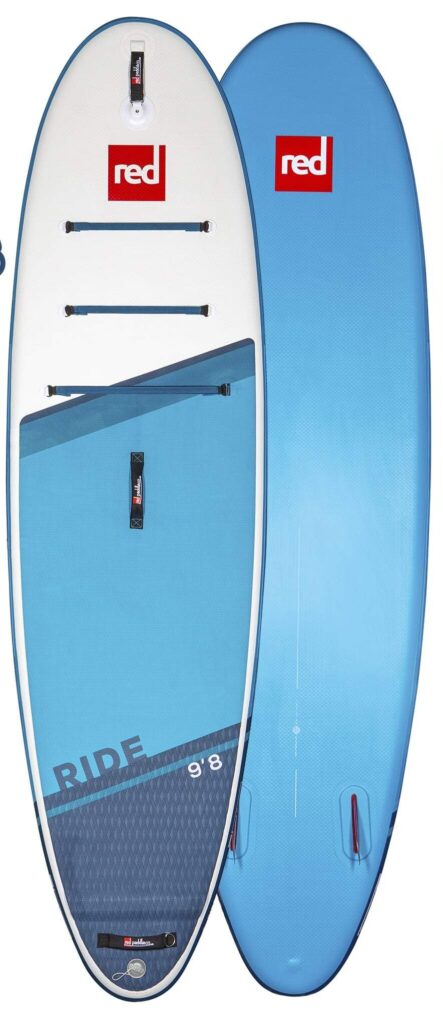

Wave SUP Boards: Conclusion
For occasional excursions and fun in smaller waves, you can also use appropriate Allround Stand Up Paddle Boards.
However, the specialized Wave SUP boards offer clear advantages for regular surfing and corresponding handling skills, especially if the waves get a little larger.
Whether you rely on the longboard variants, the short guns boards, or the fish-shape boards depends strongly on what you want to achieve in the waves. Importantly, in addition to your choice of board, you should definitely use a very sturdy long board leash in the waves, so that you are neither separated from the board or hit by it if you fall off.
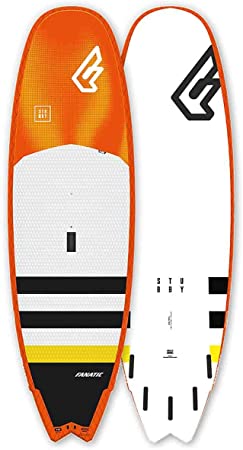
[21] Naish Hokua GTW
[25] Fanatic Stubby 7’1
River, Wild Water and Whitewater SUP Boards
Waves, currents, and streams, combined with obstacles such as boulders, narrow spots, and rapidly changing current directions, delight fans of whitewater Stand Up Paddling.
But also more leisurely river rambles are becoming more and more popular. It does not always have to be extreme whitewater riding.
The river or whitewater SUP boards, and also the paddles, are clearly specialized. They must be extremely sturdy due to the potential obstacles. Since rivers, have clear and particular risks, the wilder more so, proper and safe handling skills and special safety equipment are a must. For first excursions on the river or in white water, you should definitely join an experienced guide.
There are different types of whitewater Stand Up Paddle Boards:
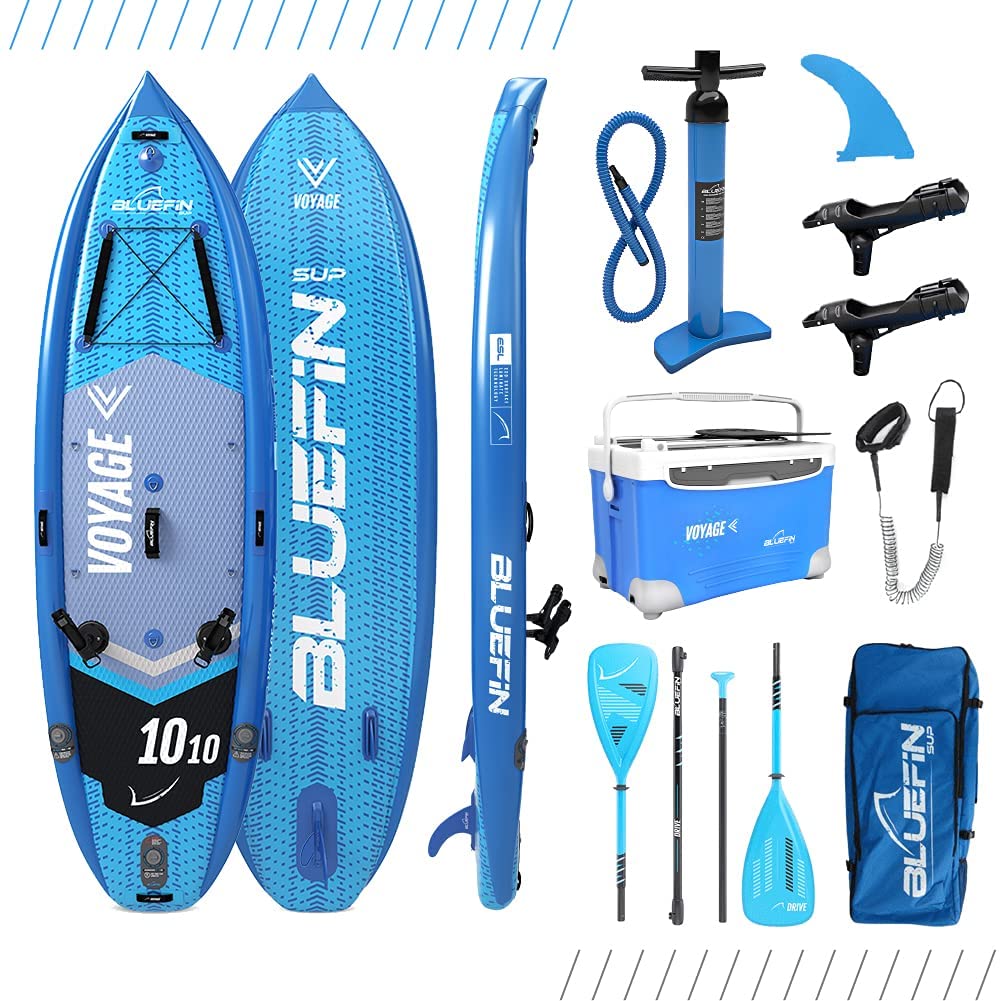
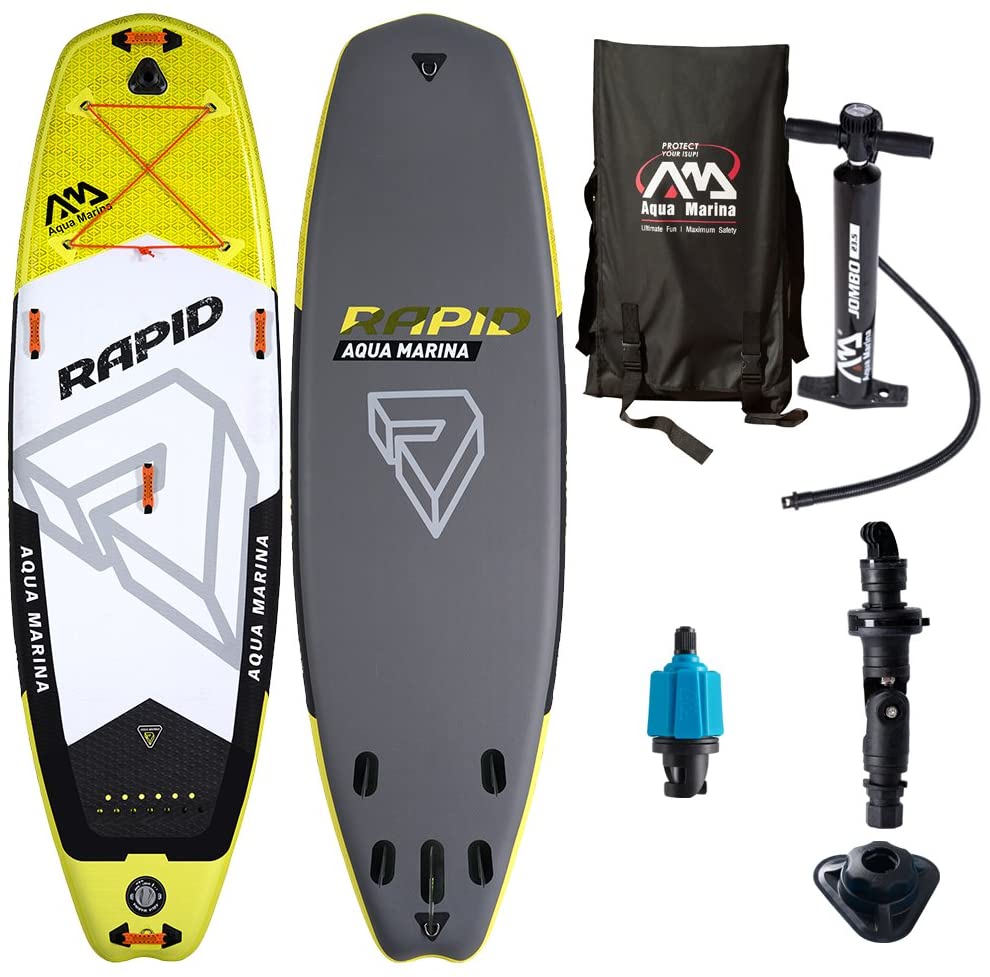
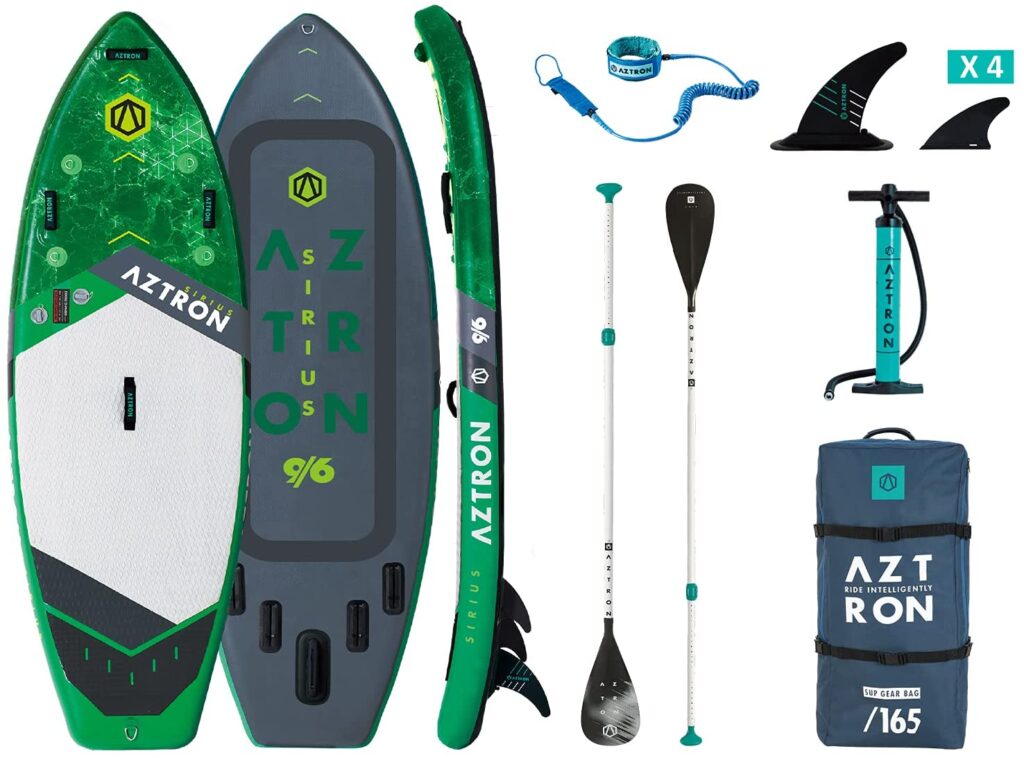
- For more comfortable river rides, cruising boards with a length of around 12 feet or typical all-round boards can be used [29].
- In slightly wilder rivers, if you are a beginner, you will need a wide and very stable board that should not be longer than 10 feet and has thick rails [26]. Such boards are easy to rotate and tilt while remaining stable, which makes riding in troubled waters easier.
- Whitewater all-round boards have a length of 9 to 10 feet and provide a nicer surfing feeling in “normal” river water. With a lot of white water and a deep riverbed (so-called “balancing water”), however, they need a better balance than normal all-round boards, and we therefore recommend them more for advanced stand up paddlers.
- Specialized whitewater boards [27], [28] are short and extremely responsive, but are definitely only for absolute experts.
- For more leisurely river rides, cruising boards with a length of around 12 feet can be used [29].
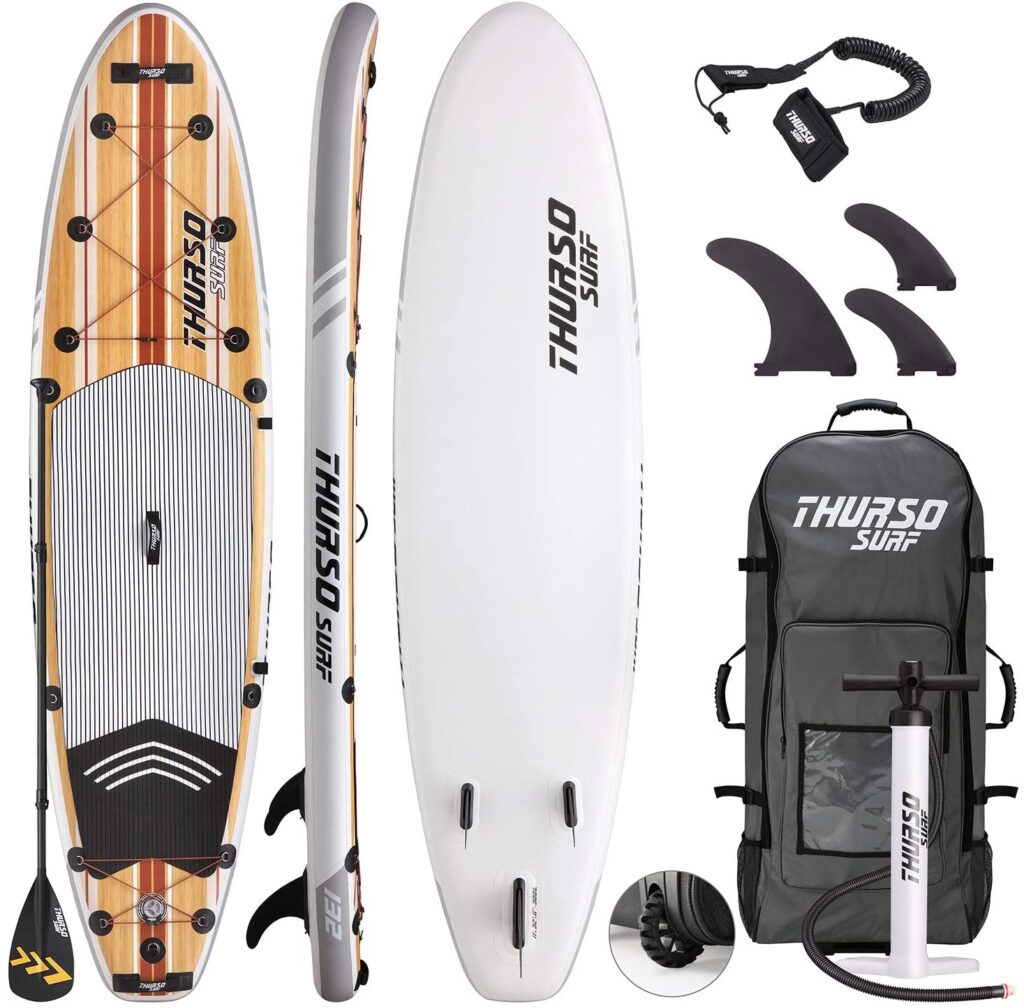
Although you can also take river trips with hard boards, the iSUPs are clearly preferable here due to their sturdiness.
However, the wilder the river becomes, the more likely you are to encounter a stone or other obstacle. Nowadays, the iSUP variants are so strong and sturdy that this is usually no problem at all. They are also easy to repair.
The fins for river stand up boards are usually made of rubber, so as to remain undamaged even when they are bumped by stones. While the river cruisers only have a single fin, whitewater boards also have a middle fin.
We recommend the cheaper Vario paddles with a soft plastic surface. The harder the paddle blade, the more likely it is to break when used in the river.
One of the most important things about river trips, as mentioned above, is safety. River paddling can be very dangerous! In addition to currents and waves, it is important to keep in mind the risk of falling on unseen stones.
Mandatory equipment for whitewater SUP are therefore:
- Helmet
- Kayak vest
- Water shoes
- knee pad
- Throwing bag and PFD (Personal Floating Device)
In addition, the coiled leash should only be mounted while in balancing water (lots of white water and deep riverbed) and only with a safety closure. Do not use the leash in blocked waters! Since all river boards are iSUP (inflatable SUP), so to speak, we also recommend purchasing a good pump.
River, Wildwater and Whitewater SUP Boards: Conclusion
Whether you are planning leisurely river trips or extreme whitewater rides, due to the sturdiness required, you should rely on an inflatable Stand Up Paddle Board.
On very quiet rivers you can, as always, also use an all-round, cruising, or trekking board. However, the wilder the river becomes, the more you need a specialty board.
The absolutely most important thing about the whitewater SUP is safety!
You absolutely must have proper knowledge of the river and the right safety equipment! In our opinion:
the best thing for carefree fun if you are not already an experienced user: Treat yourself to a guide!
[27] Aqua Marina Rapid 9.6 iSUP
[29] THURSO SURF Waterwalker
Wind SUP – Stand Up Paddle meets windsurfing
Mounting a windsurfing sail on a Stand Up Paddle Board is an obvious option: The result is the ultimate fun sports equipment for all weather conditions!
The option to mount a sail is offered with both hard boards and iSUP.
As always, there are several possibilities:
- Allround convertibles are all-round boards with a windsurfing option [30] and wide deck shape, and are ideal for beginners and for the whole family. They are well suitable for learning windsurfing and in light wind and do often come in a complete set already containing a sail.
- Thanks to the narrower deck shape, special SUP convertibles [31] enable true gliding pleasure even in stronger winds. The F2 Peak 10’8” for instance is equipped with a mast foot insert which allows a sail to be inserted at any time.
- SUP wave convertibles are even suitable for windsurfing sessions in smaller waves.
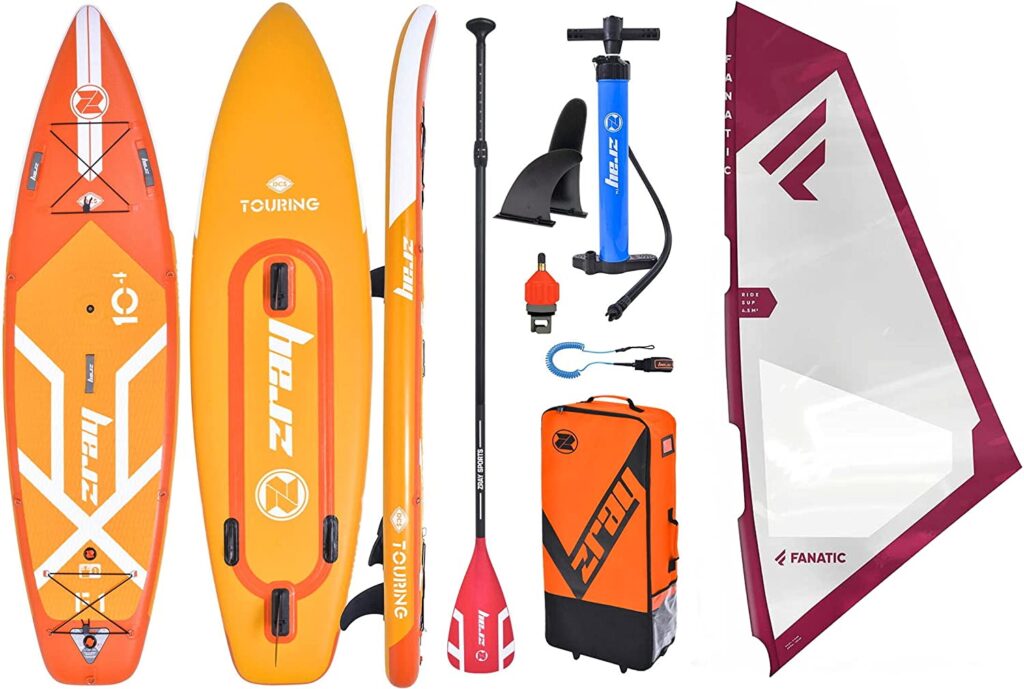

The Wind SUP Convertibles have considerable advantages over normal surfboards:
- You get a device that you can use for two different sports. So it is certainly cheaper than buying two separate pieces of equipment.
- In particular, the iSUP variants save more space and are much easier to store than comparable surfboards.
Obviously, however, even the modern wind SUP boards, especially in larger waves and stronger winds, are not complete replacements for the conventional windsurfing boards.
Wind SUP Boards: Conclusion
SUP convertibles are always an ideal choice for beginners, for both stand up paddling and windsurfing, as well as for families where fun and experimentation is the goal.
In our opinion, if you want to use a Stand Up Paddle Board for smaller pleasure tours, fun with the family, and small windsurfing sessions in light wind, the SUP convertibles are an exciting choice.
If you intend to buy a convertible, we recommend the cheaper and more compactly packaged gear, especially at the beginning.
[30] Wassersport ZRAY F1 Fury 10’4 Windsurf SUP Board
[31] Wassersport F2 Peak 10’8″ Windsurf SUP Board
[32] JP 12’0 Adventure Air SE 3DS Inflatable SUP
Yoga SUP Boards
The trend towards Stand Up Paddle Yoga and fitness has grown continuously over recent years. Initially ridiculed as a short hype, today there are special boards for this hobby. Many stand up paddle schools have also taken up this trend and now offer corresponding courses, in some cases even in winter as an indoor pool exercise!

The deck shape of “normal” yoga and fitness SUP boards is very close to the all-rounders [34], [35].
These boards therefore have very comfortable riding characteristics, which are also suitable for beginners
Of course, it is important for the entire top of the yoga and fitness stand up paddle boards to be is comfortable and soft so that you can fully focus on the exercises.
However, some brands have gone even further. For example, there are special Stand Up Paddle Boards for yoga and fitness in which the carrying handle has been moved to the edge of the board and which also offer mounting options for the paddle, all so that the athlete is not distracted during the exercises by anything. Very extreme variants even dispense with “correct” curves at the stern and bow [36].
The deck shape is therefore more of a floating rectangle and looks very similar to a yoga mat. Of course, these boards, which are solely shaped for yoga and fitness, then are no longer suitable for a paddle trip.
Yoga SUP Boards: Conclusion
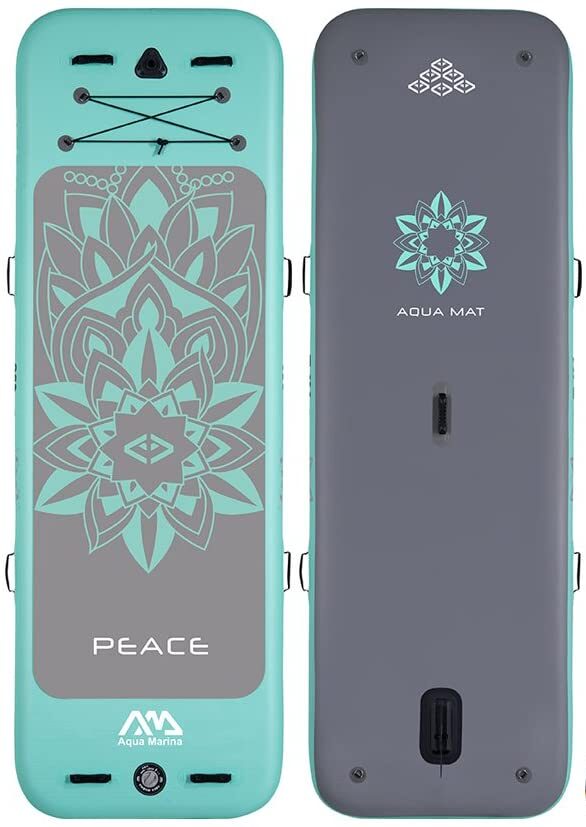
Occasional yoga or fitness exercises can be done very well on a wide all-round board with a lot of volume reserve. The advantage of this is that you can also use the same board just as well for pleasure tours.
If you are focusing solely on yoga, the specialized yoga boards are suitable. But it should be clear that these boards, except perhaps as a “play island” for children, have no further uses otherwise.
[33] Ninetysixty Yoga 10’6″ SUP
[34] Klarfit Spreestar 320 Yoga SUP Board
[36] Aqua Marina Peace Yoga SUP Board
Kid’s SUP Boards
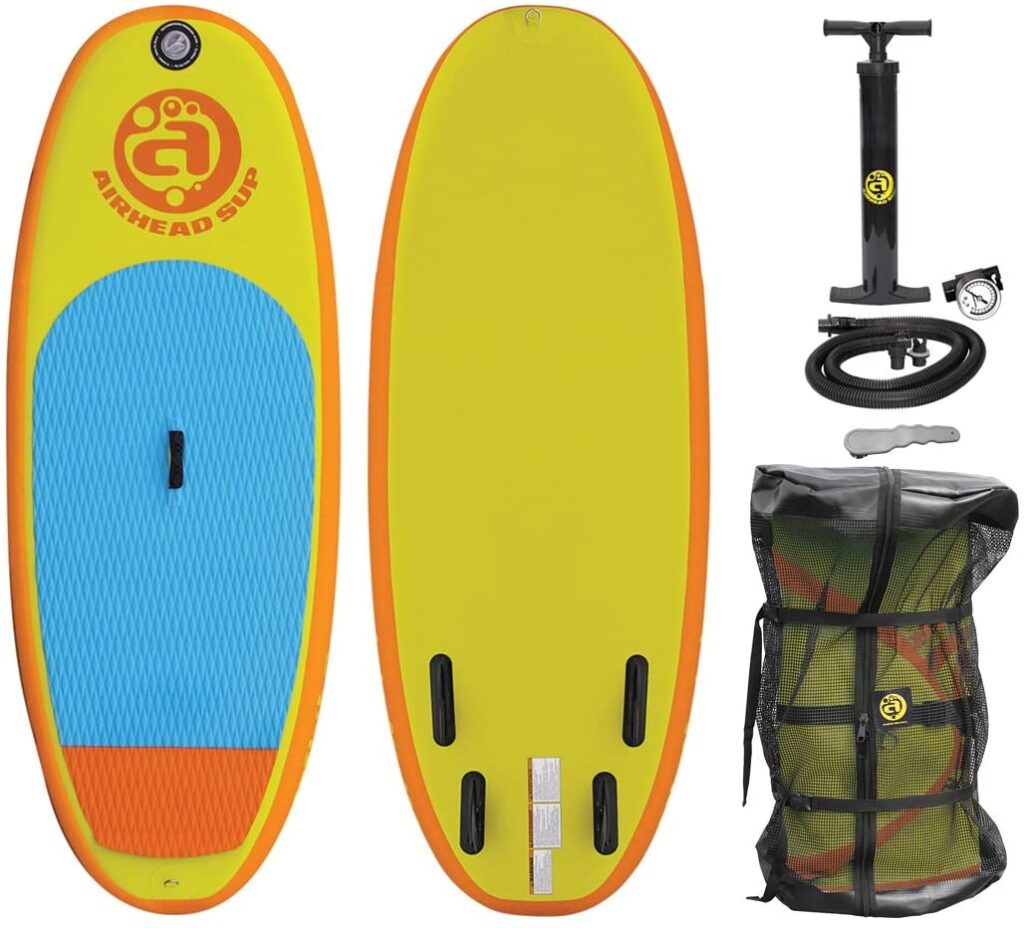
Since the adult boards are harder for children to control, there are also children’s boards for ambitious and motivated junior stand-up paddlers which are specially adapted in size.
If you want to know more about children’s boards and what to consider, just read on here.
SUP Board Selection: The bigger the choice, the harder to choose
We could list some more varieties of Stand Up Paddling, for which there are specific boards.
For example, there are boards that have a deck shape mirrored in the middle and which have fins mounted on the bow and stern: these boards are used for SUP polo. SUP polo is an action-packed 3 vs. 3 game in which a ball has to be hit into a goal with the paddle, like standard polo.
Or foil SUP boards…
And we could make the list even longer…
But how do you choose the right Stand Up Paddle Board?
We believe you should ask yourself the following questions when choosing:
1. What kind of Stand Up Paddling do I want to do?
The central question is certainly what you want to use your Stand Up Paddle Board for: Do you want to go on leisurely excursions, defeat the doldrums on the beach, or are you looking for a powerful exercise device? Thanks to these considerations, you should be able to limit your selection significantly.
Board structure, volume, length, and width ultimately all influence your riding experience, maneuverability, speed, efficiency, and stability.
Once you have decided which qualities you want most in the SUP board, it is relatively easy to find the right one.
2. Volume and weight capacity / volume:
When choosing a board, it is important to pay attention to the board volume. The indication of the volume is given in liters and thus illustrates how much weight bearing capacity it has. Consequently, the higher the volume, the more weight the board can carry.
3. Experience and skills:
The experience level primarily influences the volume to weight ratio, which you should choose.
Beginners and occasional paddlers choose a larger ratio, as this gives the board greater stability.
However, the level of experience can also influence the selection of board type (hard board or iSUP) and the hull design (flat hull vs displacement hull).
The more experienced you are, and thus the more specific requirements you have for a board type, the sooner you will look around at hard boards and boards with displacement hulls. Very good beginner boards can certainly be found at the Allrounder iSUP and do not have to cost you a fortune.
4. Length:
Of course, the type of paddleboarding you want to do also affects your choice of length. Wave surfing, river trips, or racing, etc., are different SUP “sports” and therefore require different equipment.
In general, keep in mind that longer boards glide better and stay the course, while shorter boards promise better maneuverability.
5. Width:
The width of the board affects its stability and sliding properties. As a beginner or, for example, Yoga SUPer, it is better to choose a wider board, which of course also has more tread. Narrower boards have less sliding resistance and are more suitable for speed-oriented riders or longer tours.
EVERYTHING you really have to consider when buying a SUP board…
If you made it to this point in the article, you’ve probably learned a lot about the different types of Stand Up Paddle Boards. And we hope to have helped you to understand some of the features and key points which are important.
If you now maybe made up your mind which type of SUP Board is the one for you, go over to our Buyer’s Guide. Here you will learn about a “systematic” approach to choose the right Board for you in detail including the size which should fit best for you.






